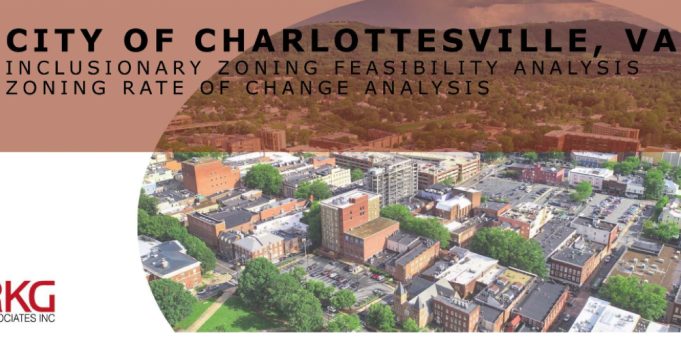By: James Higgins
It’s not something many Greene County residents are aware of, but the policies promoting ‘social justice zoning’ (SJZ), which are responsible for contention in Charlottesville, are being exported to their northern neighbor.
SJZ, which also is known as ‘inclusionary zoning’, ‘missing middle housing’, ‘equitable zoning’, and ‘upzoning’, is a social engineering program that, through the relocation of low-income families from urban neighborhoods into neighborhoods of majority white, single-family homes, seeks to eliminate structural racism in American society. Relocation necessarily is dependent on abolishing zoning restrictions in single-family neighborhoods.[1] [2] [3] [4] [5] [6]
Once restrictions are eliminated, developers are empowered to erect duplexes, townhouses, and apartment buildings (which can reach as many as nine stories) in single-family neighborhoods. Upon completion of construction, municipal or state housing agencies, nonprofits, and for-profit companies are expected to assume responsibility for finding and leasing the dwellings to low-income persons.[7]
The participation of developers in SJZ is not surprising, as – under the auspices of constructing ‘affordable housing’ – SJZ offers them the opportunity to place apartments, duplexes, and townhomes in neighborhoods zoned for single-family housing, and thus opens previously inaccessible areas to profitable ventures.[8] [9]
Realtors, in particular, are encouraged to participate in SJZ efforts. A 2018 article published in Realtor® – the online magazine of the National Association of Realtors – recommended that members explore becoming a ‘small-scale developer’, as this presents ‘….an opportunity with potential benefits for both your community and your business portfolio’. And a 2020 article in Realtor® magazine gushes over realtor Cotty Lowry, President of the Minneapolis Area Association of Realtors®, for helping a Minneapolis homeowner sell her ‘….2,378-square-foot home….for 95% of its asking price, at just over $1 million’, to a buyer who wants ‘…to tear it down and replace it with a high-end two- or three-unit complex’.[10] [11]
While advocates for SJZ claim a variety of benefits to residential neighborhoods that are persuaded (or coerced) into hosting ‘affordable housing’, many targeted localities are opposed to SJZ initiatives. Analyses of such ‘transformed’ neighborhoods reveal that SJZ practices can have deleterious effects, including spurring ‘suburban flight’ (which in turn decreases the tax base).[12] [13] [14] [15] [16]
In the greater Charlottesville area, the most prominent organization lobbying for SJZ is the Central Virginia Regional Housing Partnership (RHP), a subsidiary of the Thomas Jefferson Planning Commission. The foundational document for the RHP is ‘Planning for Affordability’, published in August 2021 as an 86-page roadmap for implementing SJZ. Along with Charlottesville and Albemarle County, ‘Planning for Affordability’ provides recommendations for Greene, Fluvanna, Nelson, and Louisa counties.[17]
The ‘Planning for Affordability’ document is careful only to explicitly advocate for mandatory ‘inclusionary zoning’ in the section devoted to the city of Charlottesville. But I find it hard to believe that the RHP has qualms about imposing this stance on other polities in the Central Virginia region.[18]
Key to the implementation of SJZ is the joint participation of progressive activists and developers. That said, the Thomas Jefferson Planning Commission is coy about the participation of the latter in their initiative. Indeed, the RHP’s mission and purpose statements do not mention the term ‘developer’. One has to do some digging to learn that the RHP Committee Members include executives with the Pinnacle Construction & Development Corporation, and Bramante Homes. A former Committee member was affiliated with Stony Point Development Group.[19] [20]
An informative way to visualize exactly how the imposition of SJZ in Charlottesville can bring major changes to the streetscape of a residential neighborhood, is provided by the YouTube videos of ‘A Nonymous’. An example of a computer-drawn simulation of ‘missing middle’ housing in a residential neighborhood in Charlottesville is provided below. [21]
Computer-drawn simulation by A. Nonymous demonstrating ‘missing middle’ housing at the corner of Locust Avenue and Calhoun Street in Charlottesville. An existing single-family home can be razed and replaced with up to four ‘RC’ lots, each lot with a multistory apartment building (red arrows).
In Charlottesville, efforts by a coalition of progressives and developers to implement SJZ have met with strong opposition, including lawsuits, from residents of city neighborhoods.[22] [23] [24] [25] [26] [27]
In Greene County, adoption of SJZ has emerged as a major goal of the Planning and Zoning Commission, whose five members are responsible, in concert with the County’s Department of Planning and Zoning, for drafting the County’s Comprehensive Plan. The 2023 Plan, which was commissioned in 2020, is designed to provide guidance on development in the County for the next five years. While the Plan cannot in itself mandate housing policies, its recommendations can serve as the basis for the drafting, and passage, by the Board of Supervisors of Greene County of ordinances intended to implement those policies.
The Greene County Planning Commission has long been known as a firm supporter of the development industry.[28] Its Chair, Ron Williams, in fact is a member of the RHP. So, it is unsurprising that the section of the 2023 Plan, titled ‘Goals and Implementation Strategies’, of the Plan’s ‘Housing and Community Services’ chapter, should be a verbatim paste-in of the Greene County recommendations outlined in the 2021 RHP ‘Planning for Affordability’ document.[29]
I note that there have been frequent proclamations by the staff of the Greene County Department of Planning and Zoning, and the members of the Greene County Planning Commission, that over the more than two years of the drafting of the Comprehensive Plan, those organizations incorporated input ‘from the community’. It is ironic that one of the most impactful sections of the entire Comprehensive Plan, in fact originates from a 2021 document authored by a coalition of progressive activists and developers headquartered in Charlottesville, and not, it would seem, from any resident(s) of Greene County.
The 2023 Comprehensive Plan incorporates all the components of SJZ as endorsed by the RHP, including provisions for the placement of ‘missing middle’ housing, and accessory dwelling units (ADUs) in residential areas. The Plan also specifically recommends the placement of ‘….mobile, manufactured, and modular homes by right in all residentially zoned districts’ (presumably, the Planning Commission was reluctant to use the term ‘trailer’).[30]
Does Greene County need affordable housing ? Certainly. However, the County government has steadfastly refused to impose mandates on developers to include affordable housing in newly approved subdivisions. For example, at the June 27, 2023 Board of Supervisors meeting, there was a public hearing on a rezoning request from Southern Development Homes to convert the 600 homes in the Woodpark subdivision from senior residential, to 300 homes senior residential and 300 homes planned unit development (P.U.D.).
In response to a Greene County resident’s concerns about how Woodpark did not include any mandates for affordable housing, James Frydl, the head of the Department of Planning and Zoning for Greene County, stated that ‘I did write down some notes, that were brought up [i.e., by the concerned resident]……the median home price today in Greene County is $432,980…..it is, sadly, the way the market is now’. And that was the end of the discussion about affordable housing at Woodpark.[31]
It’s not just the Woodpark subdivision where the County’s Department of Planning and Zoning has demurred imposing affordable housing requirements: neither the 1,100 homes in the Creekside subdivision, nor the 282 townhomes in the Village at Terrace Greene development (photograph below), have mandates to set aside dwellings for affordable housing.[32] [33]
Photograph taken in October, 2023 showing construction of the Village at Terrace Greene subdivision on Route 29 in Greene County.
Interestingly, nowhere In the County’s 2023 Comprehensive Plan is there any recommendation to the Board that the County mandate that new, or under construction, residential subdivisions set aside units for affordable housing.
On October 24, the Greene County Planning Commission, and the Department of Planning and Zoning, are expected to present a listing of ‘Comprehensive Plan Implementation Priorities’ to the Board of Supervisors for the Board’s approval. Of the 12 Priorities, No. 11 recommends that the Board ‘Encourage the development of missing middle mixed-income housing, particularly in the Ruckersville and Stanardsville areas’, along with ‘Create an Accessory Dwelling Unit implementation guide/toolkit to promote the mutual affordability benefits of ADUs to homeowners and renters & promote grant programs targeted to ADU creation’.[34]
Greene County residents need to realize that this innocuous language in fact calls for the placement, by right, of multi-story apartment buildings, townhomes, duplexes, and trailers in residential neighborhoods in the County. By so doing, the Priority puts the onus for providing affordable housing on Greene residents, and not developers.
As I stated earlier, the Planning Commission, through the Comprehensive Plan, can make recommendations to the Board of Supervisors. However, passage of ordinance(s) enabling those recommendations must be done by the Board.
As the November 7 election to fill two seats on the County Board of Supervisors draws near, Greene County residents owe it to themselves to elect individuals who will reject efforts to turn residential neighborhoods into enterprise zones for developers. For too long, the pro-development factions in Greene County have dictated land use policies in the County. It’s time to put residents first, and that includes keeping Greene’s neighborhoods free of Social Justice Zoning by electing Tim Goolsby (the write-in candidate for the Monroe District seat) and Francis McGuigan (the candidate for the At-Large seat) to the Board.
[1] The founders of Social Justice Zoning (although they did not use that term) are David Rusk, with his 1995 book Baltimore Unbound: A Strategy for Regional Renewal, and Myron Orfield, in his 1997 book Metropolitics: A Regional Agenda for Community and Stability
[2] “Apartheid by Another Name: How Zoning Regulations Perpetuate Segregation,” accessed January 5, 2023, https://nextcity.org/urbanist-news/apartheid-by-another-name-how-zoning-regulations-perpetuate-segregation.
[3] Jerusalem Demsas, “America’s Racist Housing Rules Really Can Be Fixed,” Vox, February 17, 2021, https://www.vox.com/22252625/america-racist-housing-rules-how-to-fix.
[4] The Editors, Bloomberg, “When Housing Is for Locals Only, the Whole Country Suffers,” Https://Www.Washingtonpost.Com/Business/When-Housing-Is-for-Locals-Only-the-Whole-Country-Suffers/2022/12/19/40d4698a-7fa6-11ed-8738-Ed7217de2775_story.Html, December 19, 2022.
[5] Norgaard, Stefan, “Why We Need to Build Just and Inclusive Cities / Ford Foundation,” accessed January 21, 2023, https://www.fordfoundation.org/news-and-stories/stories/posts/why-we-need-to-build-just-and-inclusive-cities/.
[6] Richard D. Kahlenberg, “The ‘New Redlining’ Is Deciding Who Lives in Your Neighborhood,” The New York Times, April 19, 2021, https://www.nytimes.com/2021/04/19/opinion/biden-zoning-social-justice.html.
[7] “Aspen Heights Partnership,” Aspen Heights Partners, accessed January 5, 2023, https://www.ahpliving.com/.
[8] “Aspen Heights Partnership.”
[9] Opticos Design, Inc., “What Is Missing Middle Housing ?,” Missing Middle Housing, accessed September 20, 2023, https://missingmiddlehousing.com/about.
[10] White, Meg, “How to Become a Small-Scale Developer,” www.nar.realtor, January 10, 2018, https://www.nar.realtor/magazine/real-estate-news/commercial/how-to-become-a-small-scale-developer.
[11] Christoffer, Erica, “One Lot, Three Homes,” www.nar.realtor, March 4, 2020, https://www.nar.realtor/magazine/real-estate-news/commentary/one-lot-three-homes.
[12] Gonzalez, Christina, “San Fernando Valley Residents Angry over Proposed Low-Income Apartments,” Fox 11 News Los Angeles, October 3, 2023, https://news.yahoo.com/san-fernando-valley-residents-angry-235111426.html.
[13] John V. Fox, “Two New Studies Challenge Notion That Upzoning Leads to More Affordable Housing,” Outside City Hall (blog), June 10, 2019, https://outsidecityhall.wordpress.com/2019/06/10/two-new-studies-challenge-notion-that-upzoning-leads-to-more-affordable-housing/.
[14] Newby, Douglas, “Homeowner’s Greatest Property Right Is Single-Family Zoning,” New Geography, August 17, 2022, https://www.newgeography.com/content/007548-homeowner-s-greatest-property-right-single-family-zoning.
[15] Phillis, Nicole, “SMa.r.t Column: Blind Upzoning’s False Promise,” Santa Monica Mirror, September 17, 2023, https://smmirror.com/2021/07/sma-r-t-column-blind-upzonings-false-promise/.
[16] “The Double-Edged Sword of Upzoning,” Brookings, accessed September 20, 2023, https://www.brookings.edu/articles/the-double-edged-sword-of-upzoning/.
[17] Thomas Jefferson Planning District Commission, “Planning for Affordability: A Regional Approach,” August 2021, https://tjpdc.org/our-work/regional-housing-plan/.
[18] Page 59 of ‘Planning for Affordability’, entry AFR-4, states: Create a mandatory inclusionary zoning policy to increase the production of affordable homes as part of all new development.
[19] “RHP Committee Members,” Central Virginia Regional Housing Partnership Website, accessed in December 15, 2022, and September 19, 2023, https://tjpdc.org/our-work/regional-housing-partnership/.
[20] “Charlottesville’s Million Dollar Housing Provider Penalty – Free Enterprise Forum,” accessed September 19, 2023, https://freeenterpriseforum.wordpress.com/2023/09/19/charlottesvilles-million-dollar-housing-provider-penalty/.
[21] Visualizing Rezoning in Charlottesville: Locust Ave at Calhoun St, May 27, 2023, A. Nonymous YouTube channel, https://www.youtube.com/watch?v=ARpHql17vag
[22] Josh Mandell, “Little High Neighborhood Association Sues City over Permitting Process,” Charlottesville Tomorrow, July 6, 2018, http://www.cvilletomorrow.org/little-high-neighborhood-association-sues-city/.
[23] Tubbs, Sean, “Lawsuit filed against city of Charlottesville for rezoning of 240 Stribling”, Information Charlottesville, May 21, 2022, https://infocville.com/2022/05/21/lawsuit-filed-against-city-of-charlottesville-for-rezoning-of-240-stribling/.
[24] Keagan Hughes, “Charlottesville Residents File Lawsuit against Charlottesville and City Council over Proposed Building,” https://www.nbc29.com, November 10, 2022, https://www.nbc29.com/2022/11/10/charlottesville-residents-file-lawsuit-against-charlottesville-city-council-building-permit/.
[25] “Fuming over FLUM,” C-VILLE Weekly, accessed September 17, 2023, https://www.c-ville.com/fuming-over-flum.
[26] Ratliff, Katie, “Plan of Attack,” C-VILLE Weekly, September 20, 2023, https://www.c-ville.com/plan-of-attack.
[27] The Schilling Show August 31, 2023: Mary Summers Whittle, podcast (WINA Newsradio,), https://wina.com/podcasts/the-schilling-show-august-31-2023-mary-summers-whittle/. Interview begins at the 19:08 mark
[28] For example, at the July 19, 2023 meeting of the Planning Commission, the main Agenda item dealt with a request from a developer to rezone a 500-home subdivision approved for Stanardsville, from residential (R-1) to planned unit development (P.U.D.). All eight speakers participating in the ‘Public Comments’ segment of the Agenda asked the Commission to defer or deny the rezoning. The Commission nonetheless voted 4-1 to recommend approval of the rezoning request to the Board of Supervisors. https://gcva.granicus.com/GeneratedAgendaViewer.php?view_id=1&clip_id=870
[29] ‘Goals and Implementation Strategies’ section of the Greene County 2023 Comprehensive Plan, pages 68 – 70, vis-a-vis pages 110 – 118 in the RHP’s ‘Planning for Affordability’ May, 2021 document, the ‘Greene County’ chapter.
[30] Greene County Planning Commission, “Comprehensive Plan, Greene County, Virginia,” May 23, 2023, pages 68 – 70, https://www.greenecountyva.gov/government/depts/planning-zoning/comprehensive-plan-review-2021.
[31]https://gcva.granicus.com/player/clip/860?view_id=1&redirect=true&h=5acbec40979af856b4f8082ad8a54346, the 29:57 mark and following
[32] James Frydl and Stephanie Golon (authors), Greene County Board of Supervisors Memorandum: Rezoning Application RZ#21-003, December 14, 2021, table on pages 5 and 6
[33] For the Village at Terrace Greene, the developer’s ‘Statement of Planning Objectives’ does not include any use of the term ‘affordable housing’, but states that ‘Market conditions will determine whether units will be leased or sold’.
[34] Greene County Planning Commission, “Comprehensive Plan Implementation Priorities,” October 10, 2023, https://gcva.granicus.com/GeneratedAgendaViewer.php?event_id=948.












